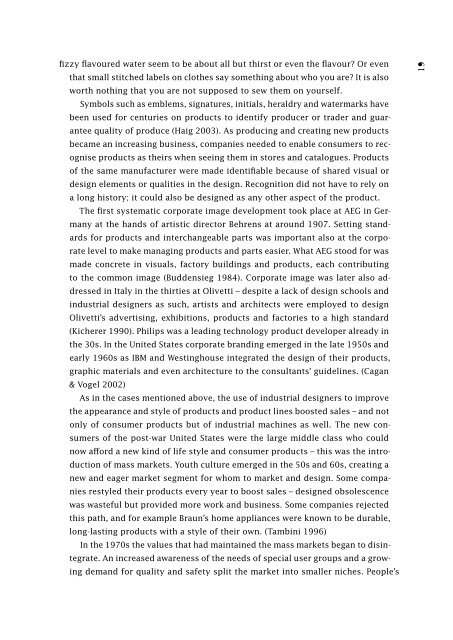Co-experience: Understanding user experiences in social interaction
Co-experience: Understanding user experiences in social interaction
Co-experience: Understanding user experiences in social interaction
You also want an ePaper? Increase the reach of your titles
YUMPU automatically turns print PDFs into web optimized ePapers that Google loves.
fizzy flavoured water seem to be about all but thirst or even the flavour? Or even<br />
that small stitched labels on clothes say someth<strong>in</strong>g about who you are? It is also<br />
worth noth<strong>in</strong>g that you are not supposed to sew them on yourself.<br />
Symbols such as emblems, signatures, <strong>in</strong>itials, heraldry and watermarks have<br />
been used for centuries on products to identify producer or trader and guarantee<br />
quality of produce (Haig 2003). As produc<strong>in</strong>g and creat<strong>in</strong>g new products<br />
became an <strong>in</strong>creas<strong>in</strong>g bus<strong>in</strong>ess, companies needed to enable consumers to recognise<br />
products as theirs when see<strong>in</strong>g them <strong>in</strong> stores and catalogues. Products<br />
of the same manufacturer were made identifiable because of shared visual or<br />
design elements or qualities <strong>in</strong> the design. Recognition did not have to rely on<br />
a long history; it could also be designed as any other aspect of the product.<br />
The first systematic corporate image development took place at AEG <strong>in</strong> Germany<br />
at the hands of artistic director Behrens at around 1907. Sett<strong>in</strong>g standards<br />
for products and <strong>in</strong>terchangeable parts was important also at the corporate<br />
level to make manag<strong>in</strong>g products and parts easier. What AEG stood for was<br />
made concrete <strong>in</strong> visuals, factory build<strong>in</strong>gs and products, each contribut<strong>in</strong>g<br />
to the common image (Buddensieg 1984). <strong>Co</strong>rporate image was later also addressed<br />
<strong>in</strong> Italy <strong>in</strong> the thirties at Olivetti – despite a lack of design schools and<br />
<strong>in</strong>dustrial designers as such, artists and architects were employed to design<br />
Olivetti’s advertis<strong>in</strong>g, exhibitions, products and factories to a high standard<br />
(Kicherer 1990). Philips was a lead<strong>in</strong>g technology product developer already <strong>in</strong><br />
the 30s. In the United States corporate brand<strong>in</strong>g emerged <strong>in</strong> the late 1950s and<br />
early 1960s as IBM and West<strong>in</strong>ghouse <strong>in</strong>tegrated the design of their products,<br />
graphic materials and even architecture to the consultants’ guidel<strong>in</strong>es. (Cagan<br />
& Vogel 2002)<br />
As <strong>in</strong> the cases mentioned above, the use of <strong>in</strong>dustrial designers to improve<br />
the appearance and style of products and product l<strong>in</strong>es boosted sales – and not<br />
only of consumer products but of <strong>in</strong>dustrial mach<strong>in</strong>es as well. The new consumers<br />
of the post-war United States were the large middle class who could<br />
now afford a new k<strong>in</strong>d of life style and consumer products – this was the <strong>in</strong>troduction<br />
of mass markets. Youth culture emerged <strong>in</strong> the 50s and 60s, creat<strong>in</strong>g a<br />
new and eager market segment for whom to market and design. Some companies<br />
restyled their products every year to boost sales – designed obsolescence<br />
was wasteful but provided more work and bus<strong>in</strong>ess. Some companies rejected<br />
this path, and for example Braun’s home appliances were known to be durable,<br />
long-last<strong>in</strong>g products with a style of their own. (Tamb<strong>in</strong>i 1996)<br />
In the 1970s the values that had ma<strong>in</strong>ta<strong>in</strong>ed the mass markets began to dis<strong>in</strong>tegrate.<br />
An <strong>in</strong>creased awareness of the needs of special <strong>user</strong> groups and a grow<strong>in</strong>g<br />
demand for quality and safety split the market <strong>in</strong>to smaller niches. People’s<br />
19

















